Human Resource Management: Factors, Forces, Strategies, and Planning
VerifiedAdded on 2023/02/01
|19
|5553
|89
Report
AI Summary
This report provides a comprehensive analysis of Human Resource Management (HRM), exploring the factors that impact both businesses and HR functions. It delves into the forces that shape the HR agenda, examines different tools for business environment analysis such as SWOT and PESTEL, and outlines the key stages in strategy development and implementation, emphasizing the role of HR. Furthermore, the report analyzes the contribution of HR to business ethics and accountability, evaluates business performance, and assesses the utilization of various data sources for effective business planning. The report covers internal and external factors that influence HRM, including leadership, mission, policies, organizational culture, conflicts, and structure, providing a detailed understanding of the complexities and strategic importance of HRM within organizations.

Running head: HUMAN RESOURCE MANAGEMENT
HUMAN RESOURCE MANAGEMENT
Name of the Student
Name of the University
Author Note
HUMAN RESOURCE MANAGEMENT
Name of the Student
Name of the University
Author Note
Paraphrase This Document
Need a fresh take? Get an instant paraphrase of this document with our AI Paraphraser
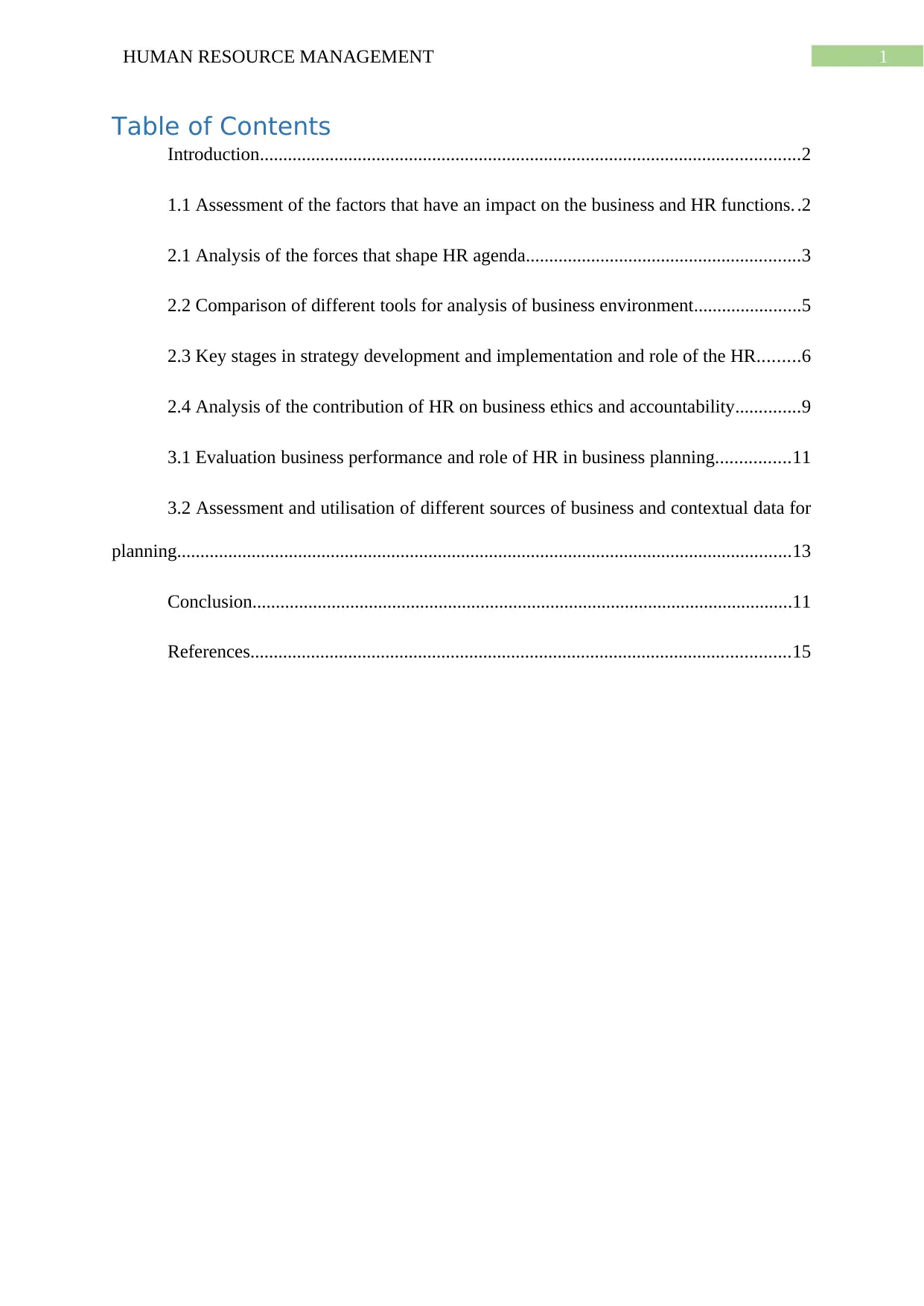
1HUMAN RESOURCE MANAGEMENT
Table of Contents
Introduction....................................................................................................................2
1.1 Assessment of the factors that have an impact on the business and HR functions. .2
2.1 Analysis of the forces that shape HR agenda...........................................................3
2.2 Comparison of different tools for analysis of business environment.......................5
2.3 Key stages in strategy development and implementation and role of the HR.........6
2.4 Analysis of the contribution of HR on business ethics and accountability..............9
3.1 Evaluation business performance and role of HR in business planning................11
3.2 Assessment and utilisation of different sources of business and contextual data for
planning....................................................................................................................................13
Conclusion....................................................................................................................11
References....................................................................................................................15
Table of Contents
Introduction....................................................................................................................2
1.1 Assessment of the factors that have an impact on the business and HR functions. .2
2.1 Analysis of the forces that shape HR agenda...........................................................3
2.2 Comparison of different tools for analysis of business environment.......................5
2.3 Key stages in strategy development and implementation and role of the HR.........6
2.4 Analysis of the contribution of HR on business ethics and accountability..............9
3.1 Evaluation business performance and role of HR in business planning................11
3.2 Assessment and utilisation of different sources of business and contextual data for
planning....................................................................................................................................13
Conclusion....................................................................................................................11
References....................................................................................................................15
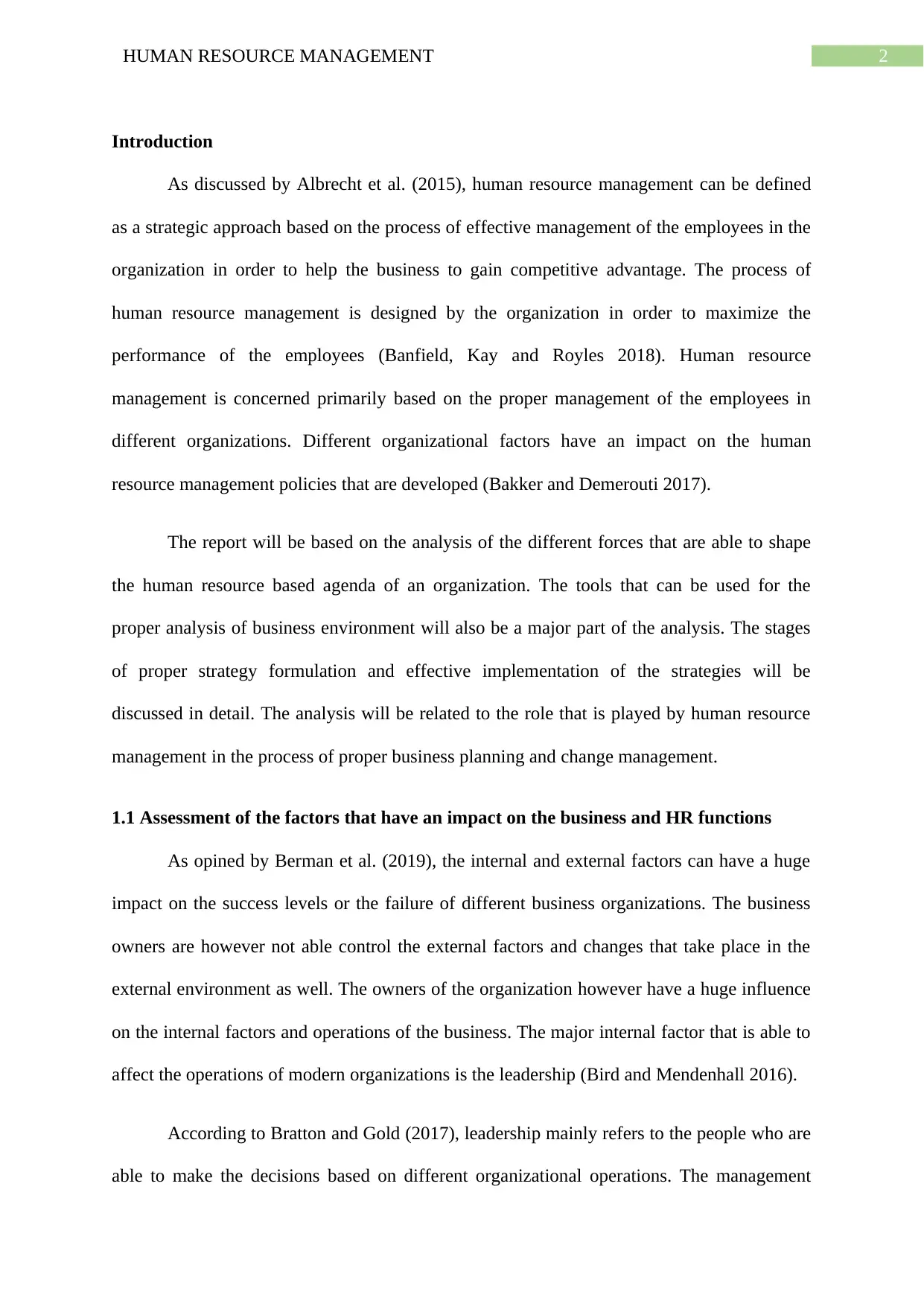
2HUMAN RESOURCE MANAGEMENT
Introduction
As discussed by Albrecht et al. (2015), human resource management can be defined
as a strategic approach based on the process of effective management of the employees in the
organization in order to help the business to gain competitive advantage. The process of
human resource management is designed by the organization in order to maximize the
performance of the employees (Banfield, Kay and Royles 2018). Human resource
management is concerned primarily based on the proper management of the employees in
different organizations. Different organizational factors have an impact on the human
resource management policies that are developed (Bakker and Demerouti 2017).
The report will be based on the analysis of the different forces that are able to shape
the human resource based agenda of an organization. The tools that can be used for the
proper analysis of business environment will also be a major part of the analysis. The stages
of proper strategy formulation and effective implementation of the strategies will be
discussed in detail. The analysis will be related to the role that is played by human resource
management in the process of proper business planning and change management.
1.1 Assessment of the factors that have an impact on the business and HR functions
As opined by Berman et al. (2019), the internal and external factors can have a huge
impact on the success levels or the failure of different business organizations. The business
owners are however not able control the external factors and changes that take place in the
external environment as well. The owners of the organization however have a huge influence
on the internal factors and operations of the business. The major internal factor that is able to
affect the operations of modern organizations is the leadership (Bird and Mendenhall 2016).
According to Bratton and Gold (2017), leadership mainly refers to the people who are
able to make the decisions based on different organizational operations. The management
Introduction
As discussed by Albrecht et al. (2015), human resource management can be defined
as a strategic approach based on the process of effective management of the employees in the
organization in order to help the business to gain competitive advantage. The process of
human resource management is designed by the organization in order to maximize the
performance of the employees (Banfield, Kay and Royles 2018). Human resource
management is concerned primarily based on the proper management of the employees in
different organizations. Different organizational factors have an impact on the human
resource management policies that are developed (Bakker and Demerouti 2017).
The report will be based on the analysis of the different forces that are able to shape
the human resource based agenda of an organization. The tools that can be used for the
proper analysis of business environment will also be a major part of the analysis. The stages
of proper strategy formulation and effective implementation of the strategies will be
discussed in detail. The analysis will be related to the role that is played by human resource
management in the process of proper business planning and change management.
1.1 Assessment of the factors that have an impact on the business and HR functions
As opined by Berman et al. (2019), the internal and external factors can have a huge
impact on the success levels or the failure of different business organizations. The business
owners are however not able control the external factors and changes that take place in the
external environment as well. The owners of the organization however have a huge influence
on the internal factors and operations of the business. The major internal factor that is able to
affect the operations of modern organizations is the leadership (Bird and Mendenhall 2016).
According to Bratton and Gold (2017), leadership mainly refers to the people who are
able to make the decisions based on different organizational operations. The management
⊘ This is a preview!⊘
Do you want full access?
Subscribe today to unlock all pages.

Trusted by 1+ million students worldwide
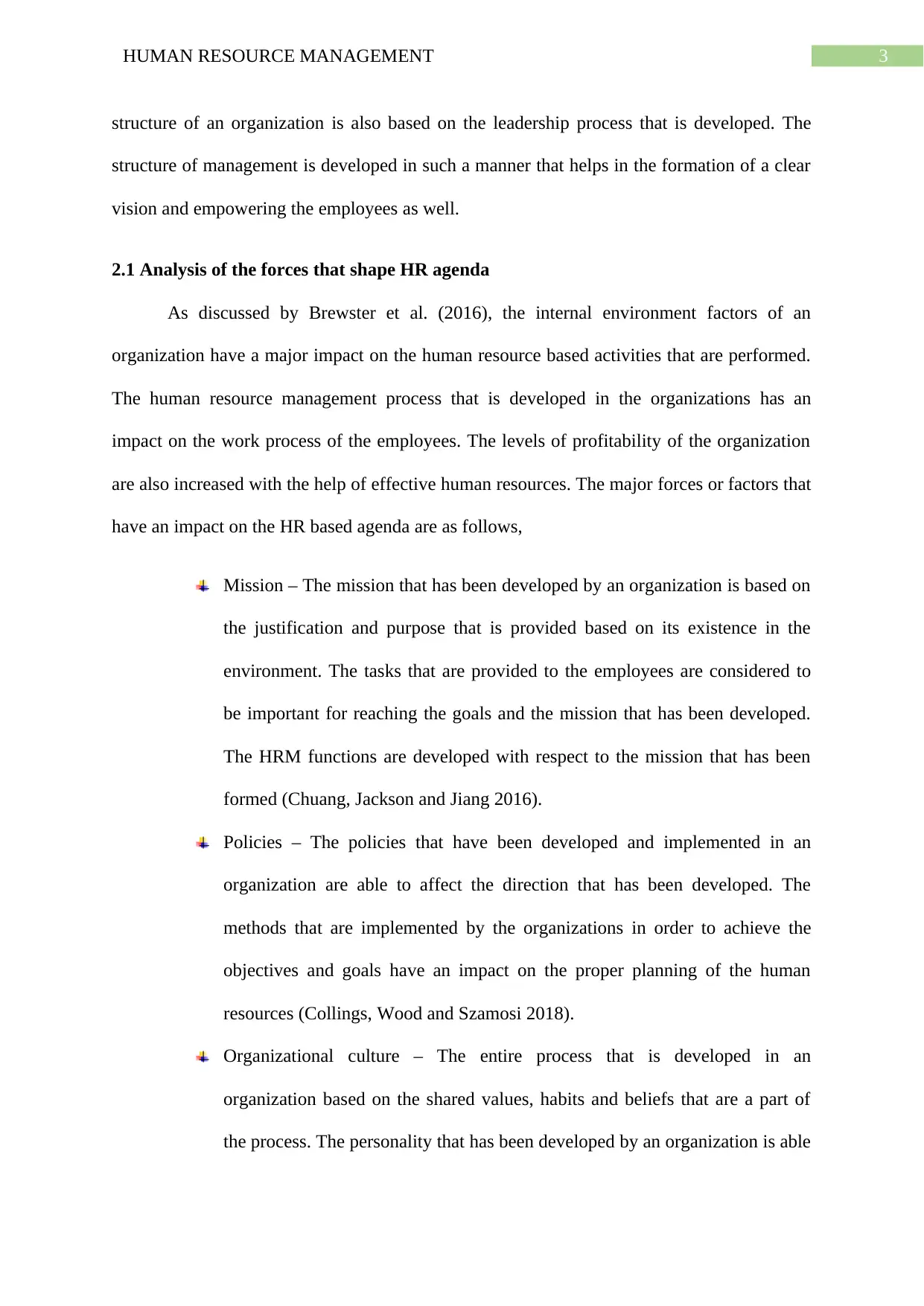
3HUMAN RESOURCE MANAGEMENT
structure of an organization is also based on the leadership process that is developed. The
structure of management is developed in such a manner that helps in the formation of a clear
vision and empowering the employees as well.
2.1 Analysis of the forces that shape HR agenda
As discussed by Brewster et al. (2016), the internal environment factors of an
organization have a major impact on the human resource based activities that are performed.
The human resource management process that is developed in the organizations has an
impact on the work process of the employees. The levels of profitability of the organization
are also increased with the help of effective human resources. The major forces or factors that
have an impact on the HR based agenda are as follows,
Mission – The mission that has been developed by an organization is based on
the justification and purpose that is provided based on its existence in the
environment. The tasks that are provided to the employees are considered to
be important for reaching the goals and the mission that has been developed.
The HRM functions are developed with respect to the mission that has been
formed (Chuang, Jackson and Jiang 2016).
Policies – The policies that have been developed and implemented in an
organization are able to affect the direction that has been developed. The
methods that are implemented by the organizations in order to achieve the
objectives and goals have an impact on the proper planning of the human
resources (Collings, Wood and Szamosi 2018).
Organizational culture – The entire process that is developed in an
organization based on the shared values, habits and beliefs that are a part of
the process. The personality that has been developed by an organization is able
structure of an organization is also based on the leadership process that is developed. The
structure of management is developed in such a manner that helps in the formation of a clear
vision and empowering the employees as well.
2.1 Analysis of the forces that shape HR agenda
As discussed by Brewster et al. (2016), the internal environment factors of an
organization have a major impact on the human resource based activities that are performed.
The human resource management process that is developed in the organizations has an
impact on the work process of the employees. The levels of profitability of the organization
are also increased with the help of effective human resources. The major forces or factors that
have an impact on the HR based agenda are as follows,
Mission – The mission that has been developed by an organization is based on
the justification and purpose that is provided based on its existence in the
environment. The tasks that are provided to the employees are considered to
be important for reaching the goals and the mission that has been developed.
The HRM functions are developed with respect to the mission that has been
formed (Chuang, Jackson and Jiang 2016).
Policies – The policies that have been developed and implemented in an
organization are able to affect the direction that has been developed. The
methods that are implemented by the organizations in order to achieve the
objectives and goals have an impact on the proper planning of the human
resources (Collings, Wood and Szamosi 2018).
Organizational culture – The entire process that is developed in an
organization based on the shared values, habits and beliefs that are a part of
the process. The personality that has been developed by an organization is able
Paraphrase This Document
Need a fresh take? Get an instant paraphrase of this document with our AI Paraphraser

4HUMAN RESOURCE MANAGEMENT
to affect the human resource policies and strategies. The human resource
managers of an organization need to adjust to the changes that have taken
place in the culture (Crane, Matten and Spence 2019). The proper
understanding of organizational culture is considered to be important for the
choice that needs to be made based on development of HR policies of the
organization. The paths that are chosen by the organization are mainly based
on the ways by which the attitudes and culture of people can be reflected
(Deery and Jago 2015).
Organizational conflicts – The conflicts that exist between the attitudes of
employees and organizational culture are considered to be important factors
that have an impact on the human resource management policies. The qualities
of employees that are able to create organizational conflicts include, personal
goals vs. organizational goals, personal ethics vs. organizational ethics, rights
vs. duties, obedience vs. self-respect, discipline vs. autonomy, authority vs.
responsibility (Donate and de Pablo 2015).
Organizational structure – The two types of organizational structures that are
implemented in different companies are, tall structure and flat structure. The
organizations that are labour oriented in nature have to implement the tall
structure This leads to the implementation of authority at the top levels
(Engert, Rauter and Baumgartner 2016). The organizations that are technology
oriented in nature implement flat organizational structure in order to distribute
the power in different levels. The proper decentralisation of authority is
mainly based on implementation of the flat structure in different organizations.
The jobs that need to be performed by the HR managers of flat structure based
to affect the human resource policies and strategies. The human resource
managers of an organization need to adjust to the changes that have taken
place in the culture (Crane, Matten and Spence 2019). The proper
understanding of organizational culture is considered to be important for the
choice that needs to be made based on development of HR policies of the
organization. The paths that are chosen by the organization are mainly based
on the ways by which the attitudes and culture of people can be reflected
(Deery and Jago 2015).
Organizational conflicts – The conflicts that exist between the attitudes of
employees and organizational culture are considered to be important factors
that have an impact on the human resource management policies. The qualities
of employees that are able to create organizational conflicts include, personal
goals vs. organizational goals, personal ethics vs. organizational ethics, rights
vs. duties, obedience vs. self-respect, discipline vs. autonomy, authority vs.
responsibility (Donate and de Pablo 2015).
Organizational structure – The two types of organizational structures that are
implemented in different companies are, tall structure and flat structure. The
organizations that are labour oriented in nature have to implement the tall
structure This leads to the implementation of authority at the top levels
(Engert, Rauter and Baumgartner 2016). The organizations that are technology
oriented in nature implement flat organizational structure in order to distribute
the power in different levels. The proper decentralisation of authority is
mainly based on implementation of the flat structure in different organizations.
The jobs that need to be performed by the HR managers of flat structure based
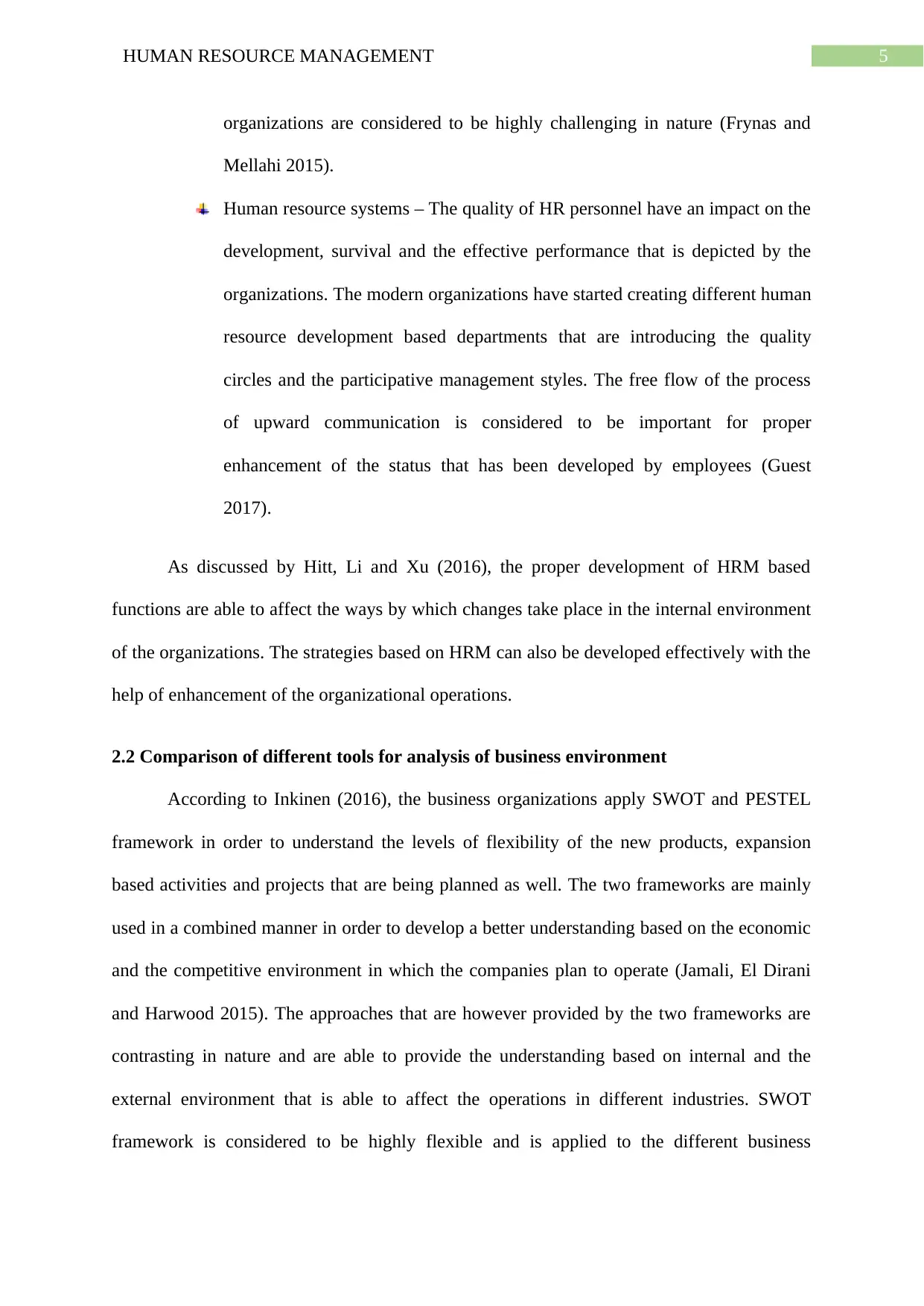
5HUMAN RESOURCE MANAGEMENT
organizations are considered to be highly challenging in nature (Frynas and
Mellahi 2015).
Human resource systems – The quality of HR personnel have an impact on the
development, survival and the effective performance that is depicted by the
organizations. The modern organizations have started creating different human
resource development based departments that are introducing the quality
circles and the participative management styles. The free flow of the process
of upward communication is considered to be important for proper
enhancement of the status that has been developed by employees (Guest
2017).
As discussed by Hitt, Li and Xu (2016), the proper development of HRM based
functions are able to affect the ways by which changes take place in the internal environment
of the organizations. The strategies based on HRM can also be developed effectively with the
help of enhancement of the organizational operations.
2.2 Comparison of different tools for analysis of business environment
According to Inkinen (2016), the business organizations apply SWOT and PESTEL
framework in order to understand the levels of flexibility of the new products, expansion
based activities and projects that are being planned as well. The two frameworks are mainly
used in a combined manner in order to develop a better understanding based on the economic
and the competitive environment in which the companies plan to operate (Jamali, El Dirani
and Harwood 2015). The approaches that are however provided by the two frameworks are
contrasting in nature and are able to provide the understanding based on internal and the
external environment that is able to affect the operations in different industries. SWOT
framework is considered to be highly flexible and is applied to the different business
organizations are considered to be highly challenging in nature (Frynas and
Mellahi 2015).
Human resource systems – The quality of HR personnel have an impact on the
development, survival and the effective performance that is depicted by the
organizations. The modern organizations have started creating different human
resource development based departments that are introducing the quality
circles and the participative management styles. The free flow of the process
of upward communication is considered to be important for proper
enhancement of the status that has been developed by employees (Guest
2017).
As discussed by Hitt, Li and Xu (2016), the proper development of HRM based
functions are able to affect the ways by which changes take place in the internal environment
of the organizations. The strategies based on HRM can also be developed effectively with the
help of enhancement of the organizational operations.
2.2 Comparison of different tools for analysis of business environment
According to Inkinen (2016), the business organizations apply SWOT and PESTEL
framework in order to understand the levels of flexibility of the new products, expansion
based activities and projects that are being planned as well. The two frameworks are mainly
used in a combined manner in order to develop a better understanding based on the economic
and the competitive environment in which the companies plan to operate (Jamali, El Dirani
and Harwood 2015). The approaches that are however provided by the two frameworks are
contrasting in nature and are able to provide the understanding based on internal and the
external environment that is able to affect the operations in different industries. SWOT
framework is considered to be highly flexible and is applied to the different business
⊘ This is a preview!⊘
Do you want full access?
Subscribe today to unlock all pages.

Trusted by 1+ million students worldwide
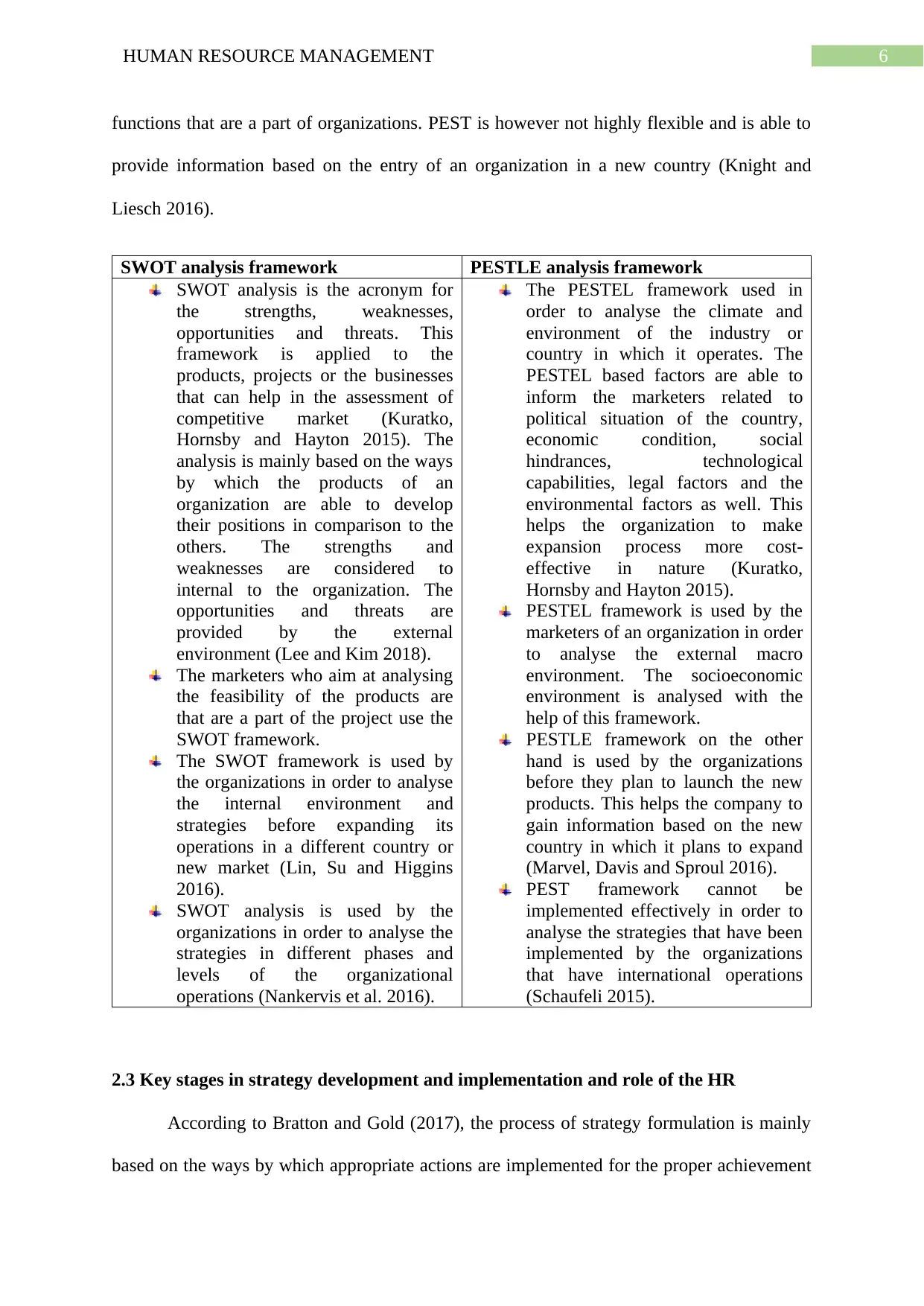
6HUMAN RESOURCE MANAGEMENT
functions that are a part of organizations. PEST is however not highly flexible and is able to
provide information based on the entry of an organization in a new country (Knight and
Liesch 2016).
SWOT analysis framework PESTLE analysis framework
SWOT analysis is the acronym for
the strengths, weaknesses,
opportunities and threats. This
framework is applied to the
products, projects or the businesses
that can help in the assessment of
competitive market (Kuratko,
Hornsby and Hayton 2015). The
analysis is mainly based on the ways
by which the products of an
organization are able to develop
their positions in comparison to the
others. The strengths and
weaknesses are considered to
internal to the organization. The
opportunities and threats are
provided by the external
environment (Lee and Kim 2018).
The marketers who aim at analysing
the feasibility of the products are
that are a part of the project use the
SWOT framework.
The SWOT framework is used by
the organizations in order to analyse
the internal environment and
strategies before expanding its
operations in a different country or
new market (Lin, Su and Higgins
2016).
SWOT analysis is used by the
organizations in order to analyse the
strategies in different phases and
levels of the organizational
operations (Nankervis et al. 2016).
The PESTEL framework used in
order to analyse the climate and
environment of the industry or
country in which it operates. The
PESTEL based factors are able to
inform the marketers related to
political situation of the country,
economic condition, social
hindrances, technological
capabilities, legal factors and the
environmental factors as well. This
helps the organization to make
expansion process more cost-
effective in nature (Kuratko,
Hornsby and Hayton 2015).
PESTEL framework is used by the
marketers of an organization in order
to analyse the external macro
environment. The socioeconomic
environment is analysed with the
help of this framework.
PESTLE framework on the other
hand is used by the organizations
before they plan to launch the new
products. This helps the company to
gain information based on the new
country in which it plans to expand
(Marvel, Davis and Sproul 2016).
PEST framework cannot be
implemented effectively in order to
analyse the strategies that have been
implemented by the organizations
that have international operations
(Schaufeli 2015).
2.3 Key stages in strategy development and implementation and role of the HR
According to Bratton and Gold (2017), the process of strategy formulation is mainly
based on the ways by which appropriate actions are implemented for the proper achievement
functions that are a part of organizations. PEST is however not highly flexible and is able to
provide information based on the entry of an organization in a new country (Knight and
Liesch 2016).
SWOT analysis framework PESTLE analysis framework
SWOT analysis is the acronym for
the strengths, weaknesses,
opportunities and threats. This
framework is applied to the
products, projects or the businesses
that can help in the assessment of
competitive market (Kuratko,
Hornsby and Hayton 2015). The
analysis is mainly based on the ways
by which the products of an
organization are able to develop
their positions in comparison to the
others. The strengths and
weaknesses are considered to
internal to the organization. The
opportunities and threats are
provided by the external
environment (Lee and Kim 2018).
The marketers who aim at analysing
the feasibility of the products are
that are a part of the project use the
SWOT framework.
The SWOT framework is used by
the organizations in order to analyse
the internal environment and
strategies before expanding its
operations in a different country or
new market (Lin, Su and Higgins
2016).
SWOT analysis is used by the
organizations in order to analyse the
strategies in different phases and
levels of the organizational
operations (Nankervis et al. 2016).
The PESTEL framework used in
order to analyse the climate and
environment of the industry or
country in which it operates. The
PESTEL based factors are able to
inform the marketers related to
political situation of the country,
economic condition, social
hindrances, technological
capabilities, legal factors and the
environmental factors as well. This
helps the organization to make
expansion process more cost-
effective in nature (Kuratko,
Hornsby and Hayton 2015).
PESTEL framework is used by the
marketers of an organization in order
to analyse the external macro
environment. The socioeconomic
environment is analysed with the
help of this framework.
PESTLE framework on the other
hand is used by the organizations
before they plan to launch the new
products. This helps the company to
gain information based on the new
country in which it plans to expand
(Marvel, Davis and Sproul 2016).
PEST framework cannot be
implemented effectively in order to
analyse the strategies that have been
implemented by the organizations
that have international operations
(Schaufeli 2015).
2.3 Key stages in strategy development and implementation and role of the HR
According to Bratton and Gold (2017), the process of strategy formulation is mainly
based on the ways by which appropriate actions are implemented for the proper achievement
Paraphrase This Document
Need a fresh take? Get an instant paraphrase of this document with our AI Paraphraser
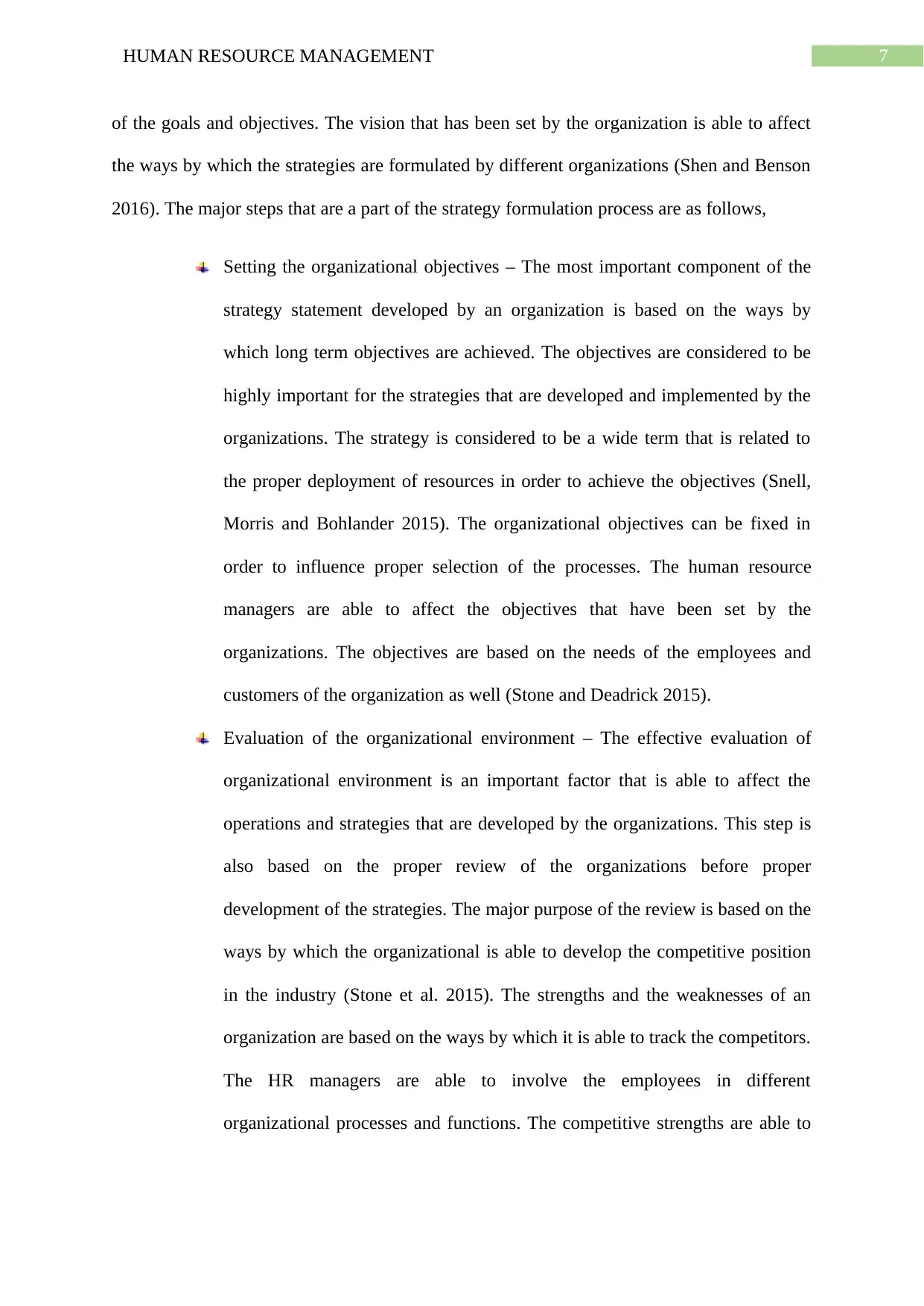
7HUMAN RESOURCE MANAGEMENT
of the goals and objectives. The vision that has been set by the organization is able to affect
the ways by which the strategies are formulated by different organizations (Shen and Benson
2016). The major steps that are a part of the strategy formulation process are as follows,
Setting the organizational objectives – The most important component of the
strategy statement developed by an organization is based on the ways by
which long term objectives are achieved. The objectives are considered to be
highly important for the strategies that are developed and implemented by the
organizations. The strategy is considered to be a wide term that is related to
the proper deployment of resources in order to achieve the objectives (Snell,
Morris and Bohlander 2015). The organizational objectives can be fixed in
order to influence proper selection of the processes. The human resource
managers are able to affect the objectives that have been set by the
organizations. The objectives are based on the needs of the employees and
customers of the organization as well (Stone and Deadrick 2015).
Evaluation of the organizational environment – The effective evaluation of
organizational environment is an important factor that is able to affect the
operations and strategies that are developed by the organizations. This step is
also based on the proper review of the organizations before proper
development of the strategies. The major purpose of the review is based on the
ways by which the organizational is able to develop the competitive position
in the industry (Stone et al. 2015). The strengths and the weaknesses of an
organization are based on the ways by which it is able to track the competitors.
The HR managers are able to involve the employees in different
organizational processes and functions. The competitive strengths are able to
of the goals and objectives. The vision that has been set by the organization is able to affect
the ways by which the strategies are formulated by different organizations (Shen and Benson
2016). The major steps that are a part of the strategy formulation process are as follows,
Setting the organizational objectives – The most important component of the
strategy statement developed by an organization is based on the ways by
which long term objectives are achieved. The objectives are considered to be
highly important for the strategies that are developed and implemented by the
organizations. The strategy is considered to be a wide term that is related to
the proper deployment of resources in order to achieve the objectives (Snell,
Morris and Bohlander 2015). The organizational objectives can be fixed in
order to influence proper selection of the processes. The human resource
managers are able to affect the objectives that have been set by the
organizations. The objectives are based on the needs of the employees and
customers of the organization as well (Stone and Deadrick 2015).
Evaluation of the organizational environment – The effective evaluation of
organizational environment is an important factor that is able to affect the
operations and strategies that are developed by the organizations. This step is
also based on the proper review of the organizations before proper
development of the strategies. The major purpose of the review is based on the
ways by which the organizational is able to develop the competitive position
in the industry (Stone et al. 2015). The strengths and the weaknesses of an
organization are based on the ways by which it is able to track the competitors.
The HR managers are able to involve the employees in different
organizational processes and functions. The competitive strengths are able to
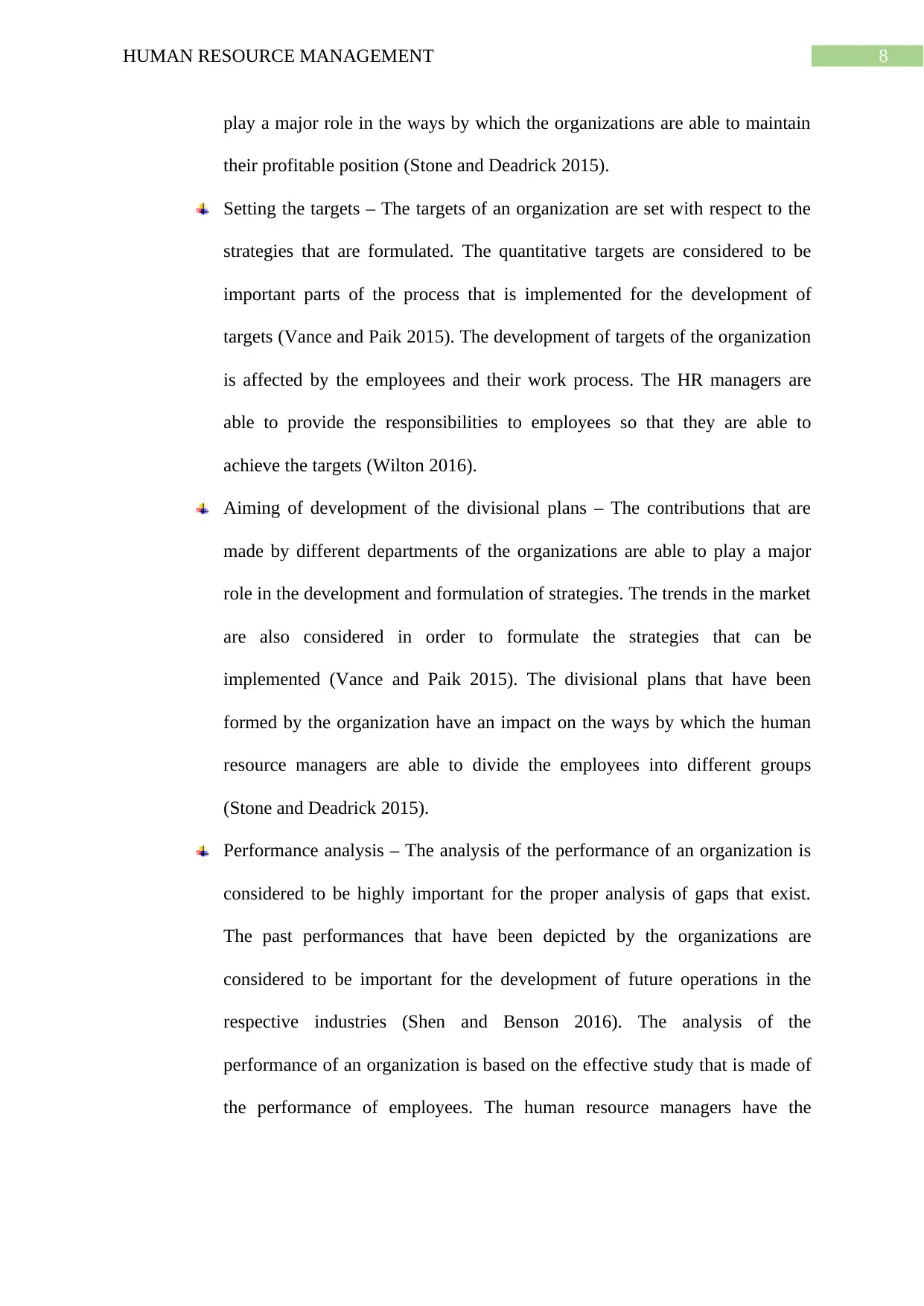
8HUMAN RESOURCE MANAGEMENT
play a major role in the ways by which the organizations are able to maintain
their profitable position (Stone and Deadrick 2015).
Setting the targets – The targets of an organization are set with respect to the
strategies that are formulated. The quantitative targets are considered to be
important parts of the process that is implemented for the development of
targets (Vance and Paik 2015). The development of targets of the organization
is affected by the employees and their work process. The HR managers are
able to provide the responsibilities to employees so that they are able to
achieve the targets (Wilton 2016).
Aiming of development of the divisional plans – The contributions that are
made by different departments of the organizations are able to play a major
role in the development and formulation of strategies. The trends in the market
are also considered in order to formulate the strategies that can be
implemented (Vance and Paik 2015). The divisional plans that have been
formed by the organization have an impact on the ways by which the human
resource managers are able to divide the employees into different groups
(Stone and Deadrick 2015).
Performance analysis – The analysis of the performance of an organization is
considered to be highly important for the proper analysis of gaps that exist.
The past performances that have been depicted by the organizations are
considered to be important for the development of future operations in the
respective industries (Shen and Benson 2016). The analysis of the
performance of an organization is based on the effective study that is made of
the performance of employees. The human resource managers have the
play a major role in the ways by which the organizations are able to maintain
their profitable position (Stone and Deadrick 2015).
Setting the targets – The targets of an organization are set with respect to the
strategies that are formulated. The quantitative targets are considered to be
important parts of the process that is implemented for the development of
targets (Vance and Paik 2015). The development of targets of the organization
is affected by the employees and their work process. The HR managers are
able to provide the responsibilities to employees so that they are able to
achieve the targets (Wilton 2016).
Aiming of development of the divisional plans – The contributions that are
made by different departments of the organizations are able to play a major
role in the development and formulation of strategies. The trends in the market
are also considered in order to formulate the strategies that can be
implemented (Vance and Paik 2015). The divisional plans that have been
formed by the organization have an impact on the ways by which the human
resource managers are able to divide the employees into different groups
(Stone and Deadrick 2015).
Performance analysis – The analysis of the performance of an organization is
considered to be highly important for the proper analysis of gaps that exist.
The past performances that have been depicted by the organizations are
considered to be important for the development of future operations in the
respective industries (Shen and Benson 2016). The analysis of the
performance of an organization is based on the effective study that is made of
the performance of employees. The human resource managers have the
⊘ This is a preview!⊘
Do you want full access?
Subscribe today to unlock all pages.

Trusted by 1+ million students worldwide
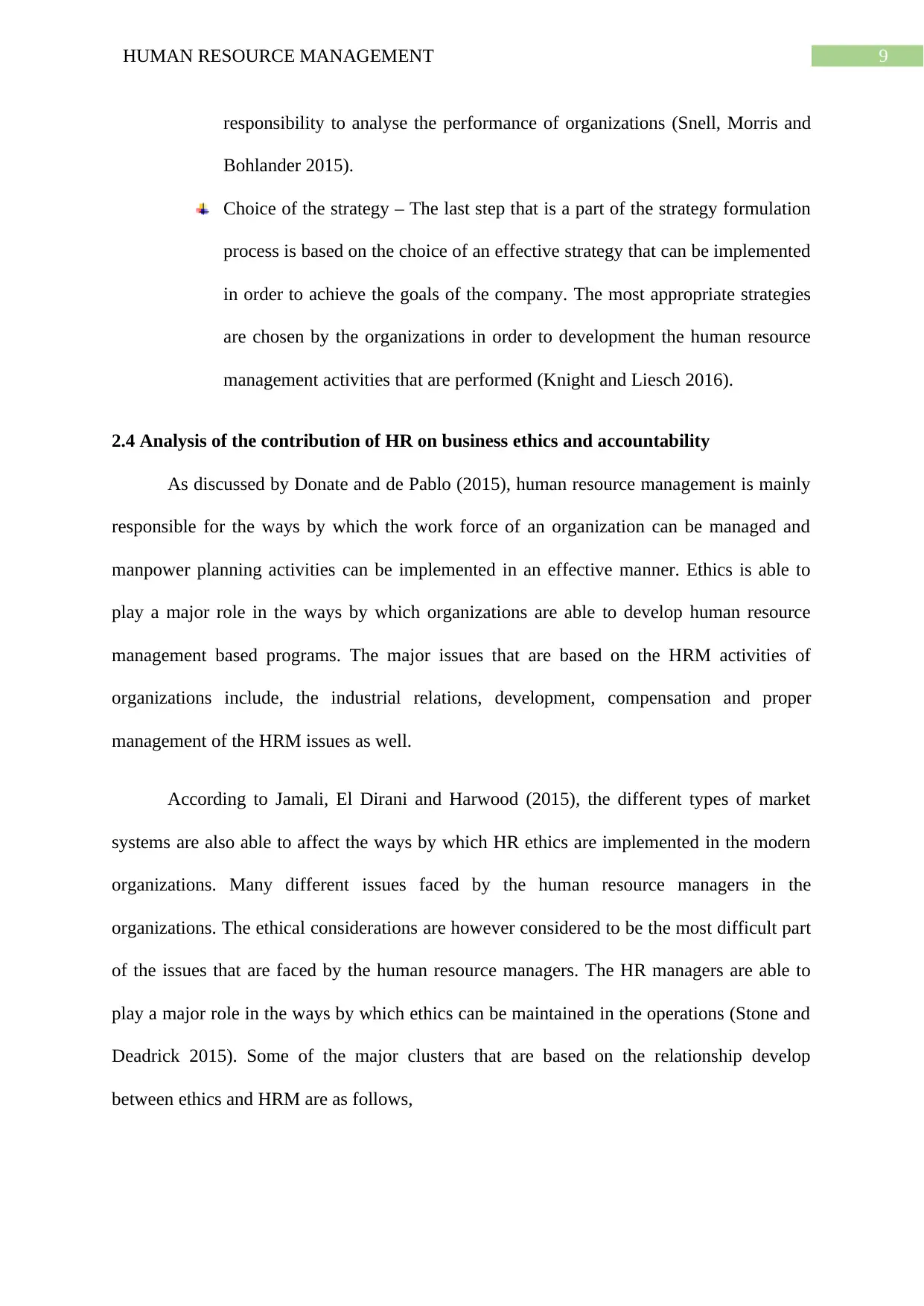
9HUMAN RESOURCE MANAGEMENT
responsibility to analyse the performance of organizations (Snell, Morris and
Bohlander 2015).
Choice of the strategy – The last step that is a part of the strategy formulation
process is based on the choice of an effective strategy that can be implemented
in order to achieve the goals of the company. The most appropriate strategies
are chosen by the organizations in order to development the human resource
management activities that are performed (Knight and Liesch 2016).
2.4 Analysis of the contribution of HR on business ethics and accountability
As discussed by Donate and de Pablo (2015), human resource management is mainly
responsible for the ways by which the work force of an organization can be managed and
manpower planning activities can be implemented in an effective manner. Ethics is able to
play a major role in the ways by which organizations are able to develop human resource
management based programs. The major issues that are based on the HRM activities of
organizations include, the industrial relations, development, compensation and proper
management of the HRM issues as well.
According to Jamali, El Dirani and Harwood (2015), the different types of market
systems are also able to affect the ways by which HR ethics are implemented in the modern
organizations. Many different issues faced by the human resource managers in the
organizations. The ethical considerations are however considered to be the most difficult part
of the issues that are faced by the human resource managers. The HR managers are able to
play a major role in the ways by which ethics can be maintained in the operations (Stone and
Deadrick 2015). Some of the major clusters that are based on the relationship develop
between ethics and HRM are as follows,
responsibility to analyse the performance of organizations (Snell, Morris and
Bohlander 2015).
Choice of the strategy – The last step that is a part of the strategy formulation
process is based on the choice of an effective strategy that can be implemented
in order to achieve the goals of the company. The most appropriate strategies
are chosen by the organizations in order to development the human resource
management activities that are performed (Knight and Liesch 2016).
2.4 Analysis of the contribution of HR on business ethics and accountability
As discussed by Donate and de Pablo (2015), human resource management is mainly
responsible for the ways by which the work force of an organization can be managed and
manpower planning activities can be implemented in an effective manner. Ethics is able to
play a major role in the ways by which organizations are able to develop human resource
management based programs. The major issues that are based on the HRM activities of
organizations include, the industrial relations, development, compensation and proper
management of the HRM issues as well.
According to Jamali, El Dirani and Harwood (2015), the different types of market
systems are also able to affect the ways by which HR ethics are implemented in the modern
organizations. Many different issues faced by the human resource managers in the
organizations. The ethical considerations are however considered to be the most difficult part
of the issues that are faced by the human resource managers. The HR managers are able to
play a major role in the ways by which ethics can be maintained in the operations (Stone and
Deadrick 2015). Some of the major clusters that are based on the relationship develop
between ethics and HRM are as follows,
Paraphrase This Document
Need a fresh take? Get an instant paraphrase of this document with our AI Paraphraser
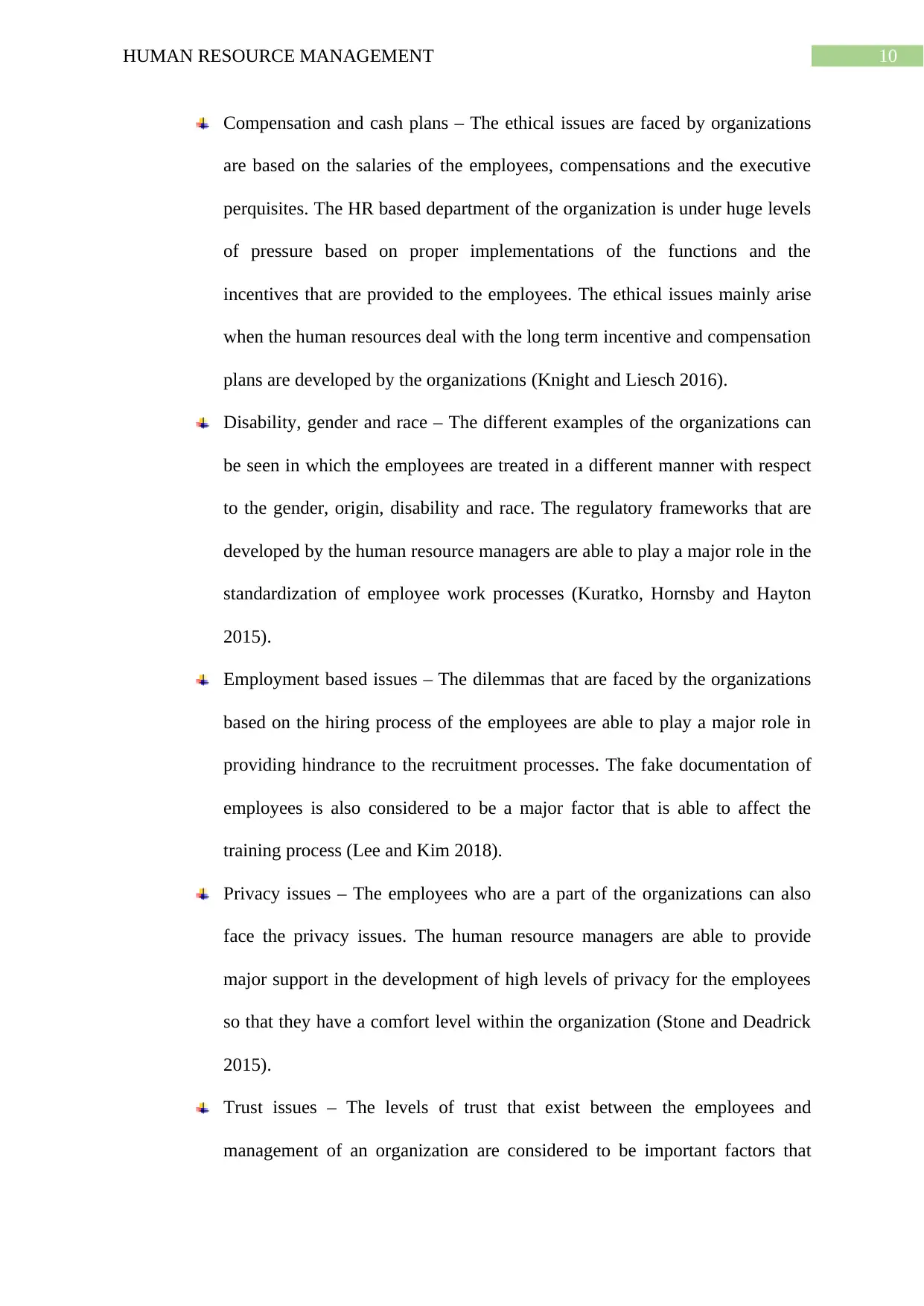
10HUMAN RESOURCE MANAGEMENT
Compensation and cash plans – The ethical issues are faced by organizations
are based on the salaries of the employees, compensations and the executive
perquisites. The HR based department of the organization is under huge levels
of pressure based on proper implementations of the functions and the
incentives that are provided to the employees. The ethical issues mainly arise
when the human resources deal with the long term incentive and compensation
plans are developed by the organizations (Knight and Liesch 2016).
Disability, gender and race – The different examples of the organizations can
be seen in which the employees are treated in a different manner with respect
to the gender, origin, disability and race. The regulatory frameworks that are
developed by the human resource managers are able to play a major role in the
standardization of employee work processes (Kuratko, Hornsby and Hayton
2015).
Employment based issues – The dilemmas that are faced by the organizations
based on the hiring process of the employees are able to play a major role in
providing hindrance to the recruitment processes. The fake documentation of
employees is also considered to be a major factor that is able to affect the
training process (Lee and Kim 2018).
Privacy issues – The employees who are a part of the organizations can also
face the privacy issues. The human resource managers are able to provide
major support in the development of high levels of privacy for the employees
so that they have a comfort level within the organization (Stone and Deadrick
2015).
Trust issues – The levels of trust that exist between the employees and
management of an organization are considered to be important factors that
Compensation and cash plans – The ethical issues are faced by organizations
are based on the salaries of the employees, compensations and the executive
perquisites. The HR based department of the organization is under huge levels
of pressure based on proper implementations of the functions and the
incentives that are provided to the employees. The ethical issues mainly arise
when the human resources deal with the long term incentive and compensation
plans are developed by the organizations (Knight and Liesch 2016).
Disability, gender and race – The different examples of the organizations can
be seen in which the employees are treated in a different manner with respect
to the gender, origin, disability and race. The regulatory frameworks that are
developed by the human resource managers are able to play a major role in the
standardization of employee work processes (Kuratko, Hornsby and Hayton
2015).
Employment based issues – The dilemmas that are faced by the organizations
based on the hiring process of the employees are able to play a major role in
providing hindrance to the recruitment processes. The fake documentation of
employees is also considered to be a major factor that is able to affect the
training process (Lee and Kim 2018).
Privacy issues – The employees who are a part of the organizations can also
face the privacy issues. The human resource managers are able to provide
major support in the development of high levels of privacy for the employees
so that they have a comfort level within the organization (Stone and Deadrick
2015).
Trust issues – The levels of trust that exist between the employees and
management of an organization are considered to be important factors that
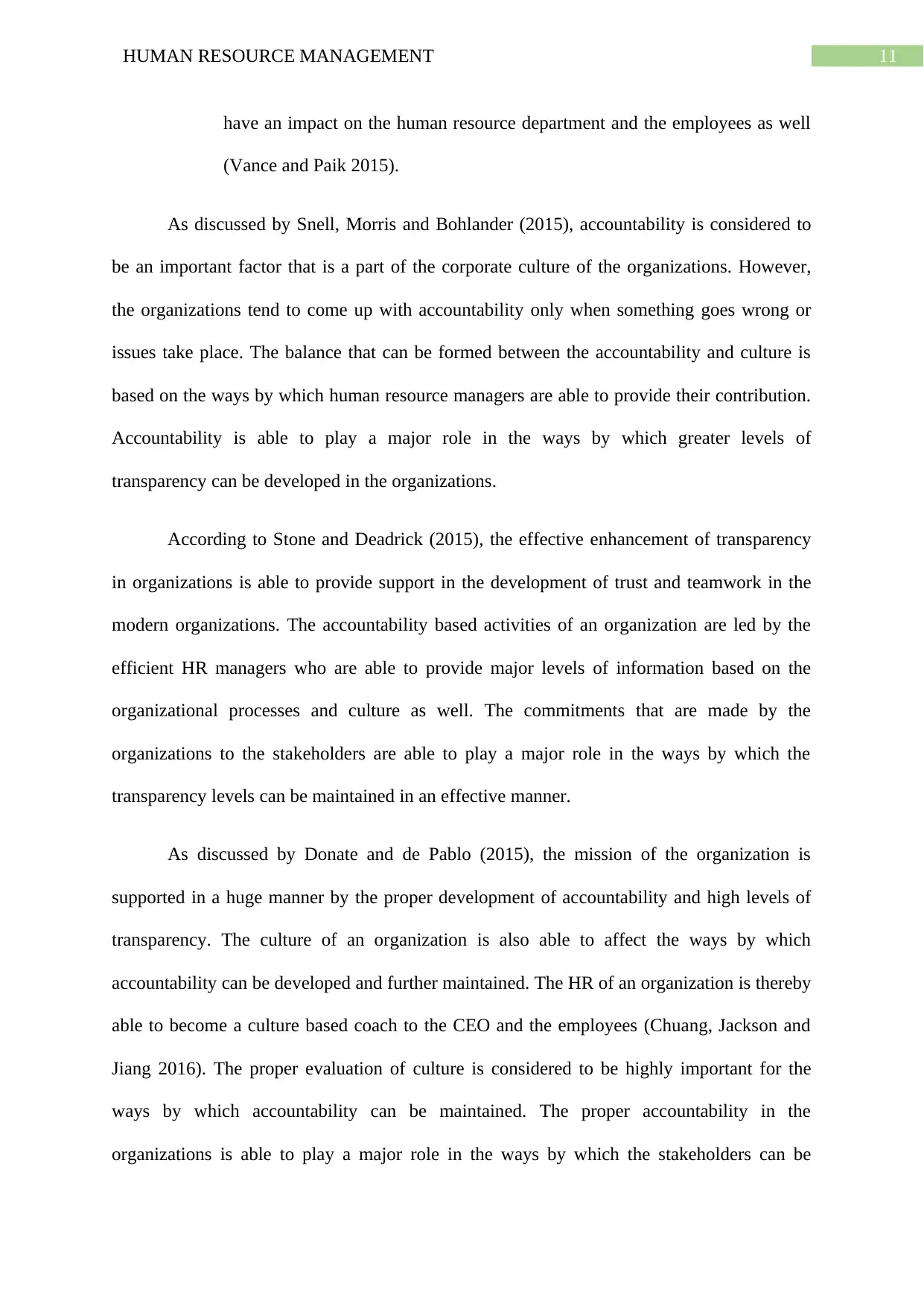
11HUMAN RESOURCE MANAGEMENT
have an impact on the human resource department and the employees as well
(Vance and Paik 2015).
As discussed by Snell, Morris and Bohlander (2015), accountability is considered to
be an important factor that is a part of the corporate culture of the organizations. However,
the organizations tend to come up with accountability only when something goes wrong or
issues take place. The balance that can be formed between the accountability and culture is
based on the ways by which human resource managers are able to provide their contribution.
Accountability is able to play a major role in the ways by which greater levels of
transparency can be developed in the organizations.
According to Stone and Deadrick (2015), the effective enhancement of transparency
in organizations is able to provide support in the development of trust and teamwork in the
modern organizations. The accountability based activities of an organization are led by the
efficient HR managers who are able to provide major levels of information based on the
organizational processes and culture as well. The commitments that are made by the
organizations to the stakeholders are able to play a major role in the ways by which the
transparency levels can be maintained in an effective manner.
As discussed by Donate and de Pablo (2015), the mission of the organization is
supported in a huge manner by the proper development of accountability and high levels of
transparency. The culture of an organization is also able to affect the ways by which
accountability can be developed and further maintained. The HR of an organization is thereby
able to become a culture based coach to the CEO and the employees (Chuang, Jackson and
Jiang 2016). The proper evaluation of culture is considered to be highly important for the
ways by which accountability can be maintained. The proper accountability in the
organizations is able to play a major role in the ways by which the stakeholders can be
have an impact on the human resource department and the employees as well
(Vance and Paik 2015).
As discussed by Snell, Morris and Bohlander (2015), accountability is considered to
be an important factor that is a part of the corporate culture of the organizations. However,
the organizations tend to come up with accountability only when something goes wrong or
issues take place. The balance that can be formed between the accountability and culture is
based on the ways by which human resource managers are able to provide their contribution.
Accountability is able to play a major role in the ways by which greater levels of
transparency can be developed in the organizations.
According to Stone and Deadrick (2015), the effective enhancement of transparency
in organizations is able to provide support in the development of trust and teamwork in the
modern organizations. The accountability based activities of an organization are led by the
efficient HR managers who are able to provide major levels of information based on the
organizational processes and culture as well. The commitments that are made by the
organizations to the stakeholders are able to play a major role in the ways by which the
transparency levels can be maintained in an effective manner.
As discussed by Donate and de Pablo (2015), the mission of the organization is
supported in a huge manner by the proper development of accountability and high levels of
transparency. The culture of an organization is also able to affect the ways by which
accountability can be developed and further maintained. The HR of an organization is thereby
able to become a culture based coach to the CEO and the employees (Chuang, Jackson and
Jiang 2016). The proper evaluation of culture is considered to be highly important for the
ways by which accountability can be maintained. The proper accountability in the
organizations is able to play a major role in the ways by which the stakeholders can be
⊘ This is a preview!⊘
Do you want full access?
Subscribe today to unlock all pages.

Trusted by 1+ million students worldwide
1 out of 19
Related Documents
Your All-in-One AI-Powered Toolkit for Academic Success.
+13062052269
info@desklib.com
Available 24*7 on WhatsApp / Email
![[object Object]](/_next/static/media/star-bottom.7253800d.svg)
Unlock your academic potential
Copyright © 2020–2025 A2Z Services. All Rights Reserved. Developed and managed by ZUCOL.





